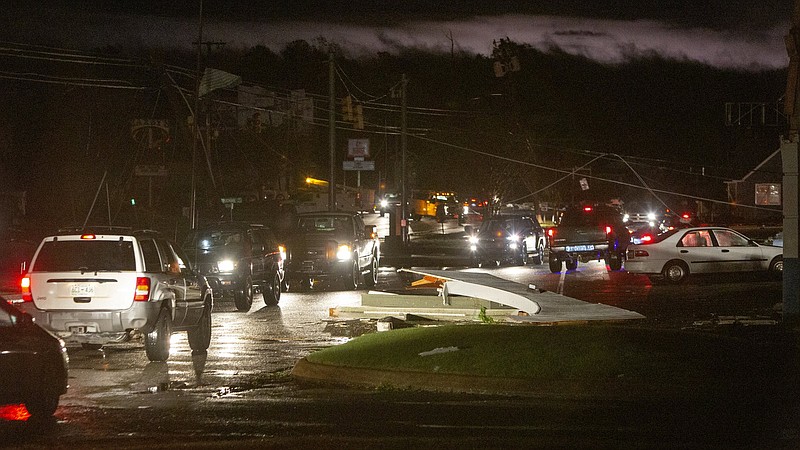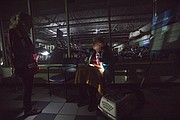There's nothing more terrifying than the whirling, roaring blackness of a tornado at night, and almost half of Tennessee's tornadoes come calling after the sun goes down.
Nearly 46% of Tennessee's tornadoes occur at night, according to Walker S. Ashley, professor of meteorology, climatology and hazards at Northern Illinois University. Ashley was part of a team that produced a study on nighttime tornadoes in 2008.
"This is the highest proportion of nocturnal tornadoes of any state in the U.S. The next closest states are Kentucky and Arkansas at around 42%," Ashley said via email.
"Overnight events are 2.5 times as likely to kill as events during the daytime, and this nocturnal fatality rate has been a major reason for the stalled decline in the national tornado fatality tallies since the 1990s," he said.
Easter Sunday night's storms rained terror on residents out of the darkness, killing three people in Hamilton County and one from flooding in Marion County.
The twisters killed seven people in Murray County, Georgia. One of the seven lives claimed was a twin daughter of Chatsworth resident Tracy Zambrano.
"The tornado blew away the trailer," Zambrano said just hours after the tragedy that unfolded in moments.
"My daughters were in there," she said, her voice wracked with pain. "The older one was holding on to her younger twin, and tried to save her life and she did. She's in the hospital."
Zambrano said the eldest of the 20-year-old twins, Deanna, kept her younger, twin sister, Breanna, from being killed, but couldn't save herself.
Despite warnings to stay out of the disaster area Monday and Tuesday along the path of Hamilton County's deadly nighttime tornado, Lauren Musselman had to get into the Holly Hills subdivision, one of the areas in East Brainerd worst hit by Sunday night's tornadoes that ravaged Chattanooga and the Southeast.
She had to see her sister in the flesh.
"She woke up from the noise and started going down the stairs to the basement," Musselman recounted her sister's experience Sunday night. "The front door followed her."
Neither sister had any warning that night. Most folks in Holly Hills had already gone to bed.
Musselman's neighbor, Neyla Locey, remembers the house started to shake around 11:25 p.m. That was the only warning of what was to come.
A combination of factors play a role in Tennessee's nation-leading statistics for nighttime tornadoes, Ashley said.
Tennessee, and its neighboring states, have a prevalence of tornadoes during cool and transition seasons when daylight is at a minimum; a prevalence of what meteorologists call "high shear/low instability" events, which is typical of the South in fall and spring; and a prevalence of linear thunderstorm events "that tend to dominate during the overnight hours," Ashley said.
According to the National Weather Service's latest survey information, Hamilton County's EF3 tornado struck at 11:19 p.m. Sunday with winds estimated at 145 mph, plowing a 1,500-yard-wide path for 14.5 miles starting 6.8 miles southeast of Chattanooga and ending in Bradley County, 5.3 miles northeast of Ooltewah, leaving three dead and 19 injured in 14 minutes.
TORNADO FAST FACTS
The following is an excerpt from National Severe Storms Laboratory's "Severe Weather 101 - Tornadoes" page. What is a tornado? A tornado is a narrow, violently rotating column of air that extends from a thunderstorm to the ground. Because wind is invisible, it is hard to see a tornado unless it forms a condensation funnel made up of water droplets, dust and debris. Tornadoes can be among the most violent phenomena of all atmospheric storms. Where do tornadoes occur? Tornadoes occur in many parts of the world, including Australia, Europe, Africa, Asia and South America. Even New Zealand reports about 20 tornadoes each year. Two of the highest concentrations of tornadoes outside the U.S. are Argentina and Bangladesh. How many tornadoes occur in the U.S. each year? About 1,200. Since official tornado records only date back to 1950, we do not know the actual average number of tornadoes that occur each year. Plus, tornado spotting and reporting methods have changed a lot over the past several decades, which means that we are observing more tornadoes that actually happen. Source: National Severe Storms Laboratory
In just 10 minutes, the deadly tornado that formed at 9:45 p.m. Sunday in Murray County strengthened to an EF2 storm with 130-135 mph winds that carved a 7.8-mile-long path nearly half a mile wide from 4.3 miles northwest of Chatsworth to 3.6 miles southwest of Cisco, killing seven people north of Chatsworth in neighborhoods near Deer Park Drive and Ridgeview Circle, according to the weather service's survey. The tornado is believed to have lifted just before Sumac Ridge east of U.S. Highway 411.
Kelsey N. Ellis, professor of climatology and meteorology at the University of Tennessee, Knoxville, also has studied nighttime tornadoes as part of her work on tornadoes, hurricanes and the human environment. Ellis said a breakdown of how many nighttime tornadoes occur in Tennessee shows 47% in East Tennessee happen at night, compared to 45% of tornadoes in West Tennessee, and 50% in Middle Tennessee.
Ashley and Ellis agreed that tornadoes from linear storm events were most likely to happen overnight in cooler months.
FEMA notes in its recommendations that winter tornadoes are dangerous because few people expect them. It's a good idea to have a National Oceanic and Atmospheric Administration weather radio at the bedside, an emergency kit, a designated safe room with no windows, preferably in a basement, and a family communication plan, emergency management officials say.
Ashley said it's especially important for anyone living in vulnerable housing such as mobile homes to take these precautions because there's so little time to react.
"Nocturnal events pose significant hurdles for the warning system," Ashley said.
"People tend to be asleep or have a much greater tendency to be unaware of possible environmental cues, which in many cases are important for initiating sheltering," he said. "Tornadoes at night affect folks in vulnerable housing rather than typical daytime places of shelter such as sturdier businesses and schools. Spotters are often hamstrung due to visibility issues at night, making verification of an event and dissemination of that information to the [National Weather Service] difficult. This is why the NWS's radar system is a critical piece to the puzzle."
A tornado outbreak earlier this year that cut a swath west to east across Tennessee's middle, according to weather service records, was the worst since the devastating April 24-28, 2011, super outbreak. Those storms spawned at least 362 confirmed tornadoes that killed at least 324 people across the country.
Of those tornadoes, 199 touched down in Alabama, Georgia, Mississippi and Tennessee on April 27, 2011, killing 25 in Tennessee, 14 in Georgia and 246 in Alabama. Nationwide deaths in that super outbreak superseded other history-making super outbreaks on March 21, 1932, and on April 3, 1974.
Several of the Chattanooga area's deadliest storms in 2011 struck in the predawn hours in Alabama, and at night in Tennessee and North Georgia. In 2014, North Alabama experienced its all-time deadliest outbreak.
Data on the deadly EF4 tornado on March 2 in the Nashville area that claimed more than two dozen lives was a "worst-case" combination of elements, Ashley said. It was a rain-wrapped tornado moving through urban areas of the city and suburbs, as well as "relatively high population density rural regions" where there was more vulnerable housing.
"It's all these different vulnerabilities mixing that keep forecasters and emergency managers literally up at night, worrying about what can and will occur," Ashley said.
Ellis noted Tennesseans are aware of alert notification issues with nighttime storms.
"We surveyed Tennessee residents and found that fewer than half thought they would get a tornado warning if it happened at night, compared to over 80% who believe they would get a daytime warning," Ellis said.
"Participants listed troublesome ways they would expect to receive warnings, such as sirens, which are not built to alert people sleeping indoors of a tornado threat," Ellis said.
Staff writer Meghan Mangrum contributed to this story.
Contact Ben Benton at bbenton@timesfreepress.com or 423-757-6569. Follow him on Twitter @BenBenton or at www.facebook.com/benbenton1.

